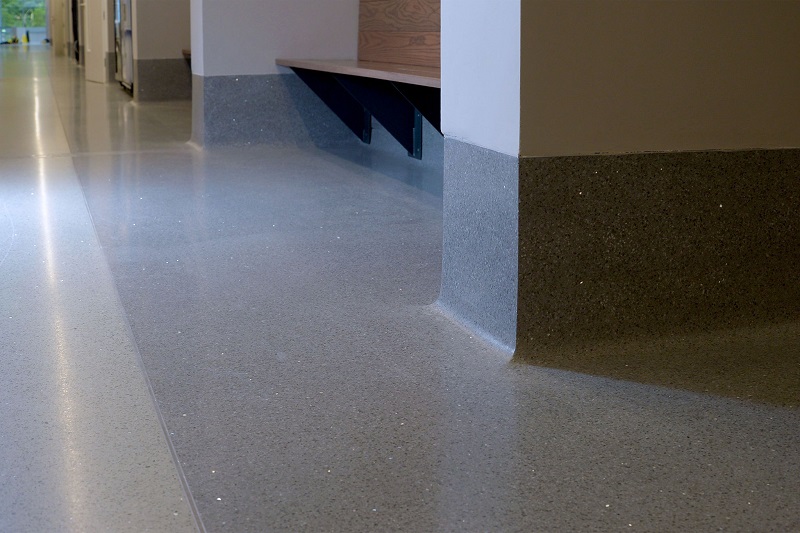Resin flooring
Resin flooring produces a hard-wearing 'plastic' surface. Its highly durable finish means that it is a popular design choice for heavy-use environments such as pharmaceutical, chemical, storage and logistics areas, commercial and public areas.
Typically, resin floors comprise a primer which penetrates and reacts with a substrate layer (usually concrete), creating a high-strength bond. A body coat of resin is then applied on top of the primer, and this creates the bulk of the floor thickness, the decorative finish and key performance characteristics such as impact resistance. Typically, 1-3 seal coats will then be used to encapsulate the body coat and provide additional performance characteristics, such as resistance to chemicals and wear.
The main types of resin used are:
- Epoxy.
- Methyl methacrylate (MMA).
- Polyurethane (PU).
Other ingredients can be added, such as; aggregates, decorative chips/flakes, pigments, cement powder, specific chemical resistance additives and so on. This may increase the thickness of the body coat.
As well as being tougher in compression than concrete, resin flooring can have some stress flexibility, which makes it durable under impact and thermal shock. In addition to its greater compressive strength, resin can dissipate loading and increase the base concrete’s weight-bearing limit.
Other advantages of resin flooring include:
- Ease of maintenance.
- An impervious barrier is created enabling the flooring to be easily cleaned and meaning they don’t harbour bacteria.
- Slip-resistant versions can be created by adding graded aggregates within the base layer, creating safer environments.
- Design flexibility is possible due to a huge range of available finishes.
- There do not need to be joints in the surface layer.
[edit] Related articles on Designing Buildings Wiki
Featured articles and news
Government consultations for the summer of 2025
A year of Labour, past and present consultations on the environment, the built environment, training and tax.
CMA competitiveness probe of major housing developers
100 million affordable housing contributions committed with further consultation published.
Homes England supports Greencore Homes
42 new build affordable sustainable homes in Oxfordshire.
Zero carbon social housing: unlocking brownfield potential
Seven ZEDpod strategies for brownfield housing success.
CIOB report; a blueprint for SDGs and the built environment
Pairing the Sustainable Development Goals with projects.
Types, tests, standards and fires relating to external cladding
Brief descriptions with an extensive list of fires for review.
Latest Build UK Building Safety Regime explainer published
Key elements in one short, now updated document.
UKGBC launch the UK Climate Resilience Roadmap
First guidance of its kind on direct climate impacts for the built environment and how it can adapt.
CLC Health, Safety and Wellbeing Strategy 2025
Launched by the Minister for Industry to look at fatalities on site, improving mental health and other issues.
One of the most impressive Victorian architects. Book review.
Common Assessment Standard now with building safety
New CAS update now includes mandatory building safety questions.
RTPI leader to become new CIOB Chief Executive Officer
Dr Victoria Hills MRTPI, FICE to take over after Caroline Gumble’s departure.
Social and affordable housing, a long term plan for delivery
The “Delivering a Decade of Renewal for Social and Affordable Housing” strategy sets out future path.
A change to adoptive architecture
Effects of global weather warming on architectural detailing, material choice and human interaction.
The proposed publicly owned and backed subsidiary of Homes England, to facilitate new homes.
How big is the problem and what can we do to mitigate the effects?
Overheating guidance and tools for building designers
A number of cool guides to help with the heat.
The UK's Modern Industrial Strategy: A 10 year plan
Previous consultation criticism, current key elements and general support with some persisting reservations.
Building Safety Regulator reforms
New roles, new staff and a new fast track service pave the way for a single construction regulator.

























